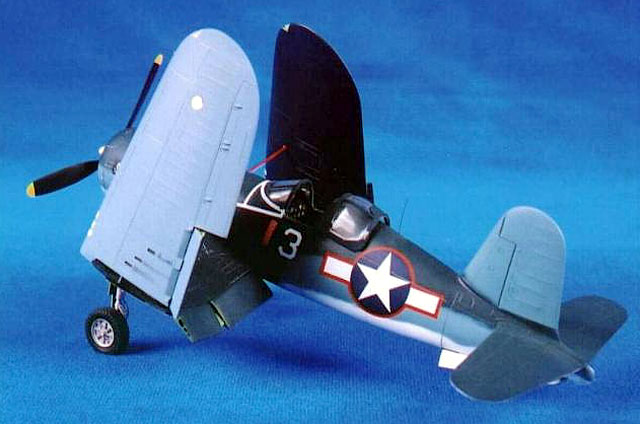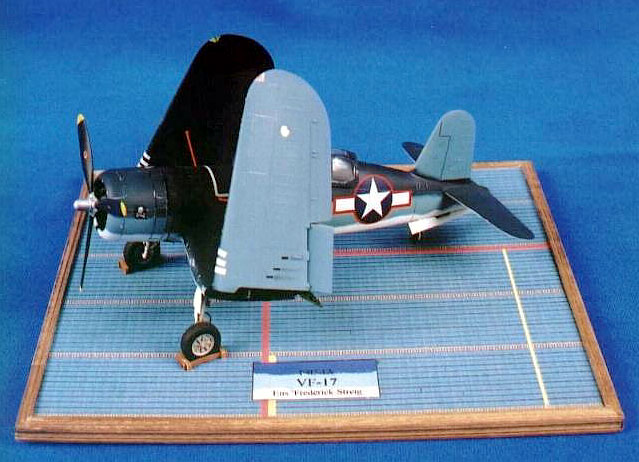|
Vought F4U-1A
Corsair
by Mike Robinson
|

|
|
Vought F4U-1A Corsair |

Hobbycraft's 1/48
scale F4U-1A Corsair is available online from Squadron.com
This is Hobbycraft’s much-maligned 1/48th scale F4U-1A
that I built when the kit first came out about 6 years ago.
I really don’t understand what all the fuss is about. I
thought it was a decent kit. It may be a little chubby around the
middle, but when it’s done it looks like a Corsair, and that to me is
all that matters.
When I read an article or when someone tells me a kit is
no good, it becomes a challenge to me of sorts, to build it and prove
that a “bad” kit can indeed be built into a nice model. This is, in
fact, the third Hobbycraft Corsair I have built. I also made a birdcage,
and used Falcon’s vacuform conversion set to build an F2G.
Other than some fiddling with the flaps to get them to
fit okay, I thought the kit went together really well.
I went one step further and folded the wings on mine. I
used bits and pieces of the wing fold parts from a Verlinden Corsair
Update set that a fellow modeler didn’t want to use, and modified it for
use on the Hobbycraft kit. Using the ribs and hinge assembly, I soldered
the pieces together, rather than trusting Superglue. The only thing
supporting the wings to the root is a small piece of photo etch, and the
red plastic rod supports, because I wanted it strong. I used the forward
halves of the photo etch ribs, and built up the rear half out of .005
sheet and plastic strip to match the contours of the PE pieces. Plastic
rod was used for the flap actuators on the outboard wing folds, and wire
used for the hydraulic lines. These were all epoxied into place inside
the wing halves, and also contribute to a little structural strength.
The flaps were corrected and detail added, and installed in the dropped
position.
The landing gear wells were detailed, as were the
landing gear struts themselves.

The kit engine plug was discarded in favor of a full two
row R2800 from Hi-Tech, appropriately detailed with wire looms and
pushrods.
The cockpit was corrected, dumping the kit floor for a
scratchbuilt interior without the floor, and stringers and longerons
were added to simulate the inside of the fuselage structure. The
instrument panel is Reheat Gauges, det in place over the kit panel.
Setting solvent was used to get the decals to conform to the kit gauges,
and it gave a nice 3D effect. The gunsight was scratchbuilt, as was the
seat and control stick, and the rudder pedals and foot rests.
Wingtip lights are CA, gradually built up, sanded and
polished to shape, as are the Formation Assembly lights and landing
lights. The tail wheel was corrected and detailed.
Painting, Decals
and Finishing Touches
|
 Aeromaster
decals and Floquil Military Colors round out the finish. Aeromaster
decals and Floquil Military Colors round out the finish.
I made the base using label paper and I did my own
carrier deck pattern and printed it on an ink jet printer.
The model garnered a Second Place at Syrcon in the
1/48th Allied class (out of over 60 entries) so I was pleased with the
outcome. It was satisfying to me to have several people ask me if it was
the Tamiya Corsair, and to see the look on their faces when I told them
it was the Hobbycraft!
I’d like to thank Tom Johnson of Rochester New York for the photography.
Model and Text Copyright © 2002 by
Mike Robinson
Images Copyright © 2002 by Tom Johnson
Page Created 08 October, 2002
Last Updated 04 June, 2007
Back to HyperScale
Main Page
Back to Features Index
|
Home
| What's New |
Features |
Gallery |
Reviews |
Reference |
Forum |
Search